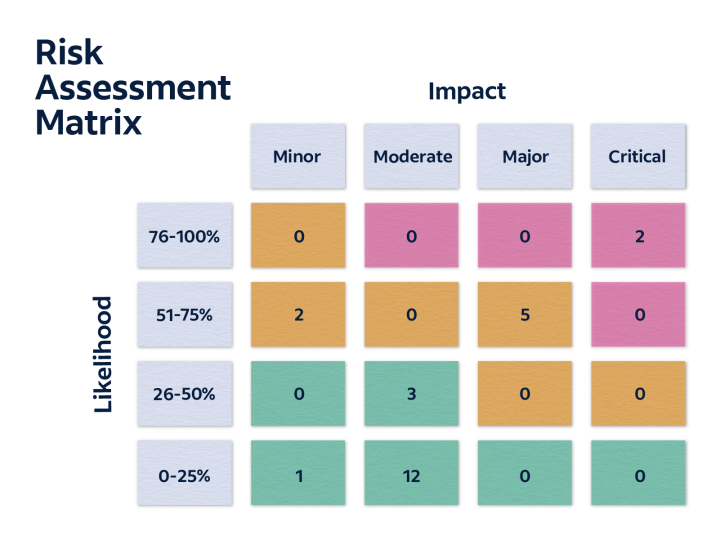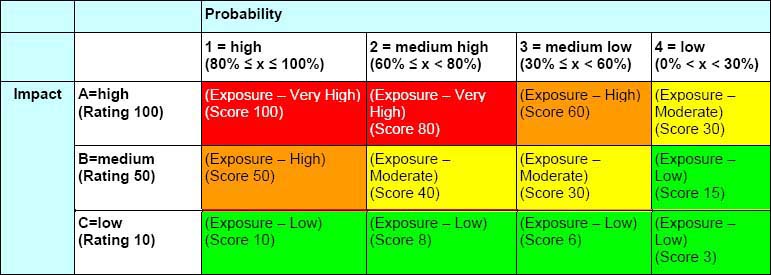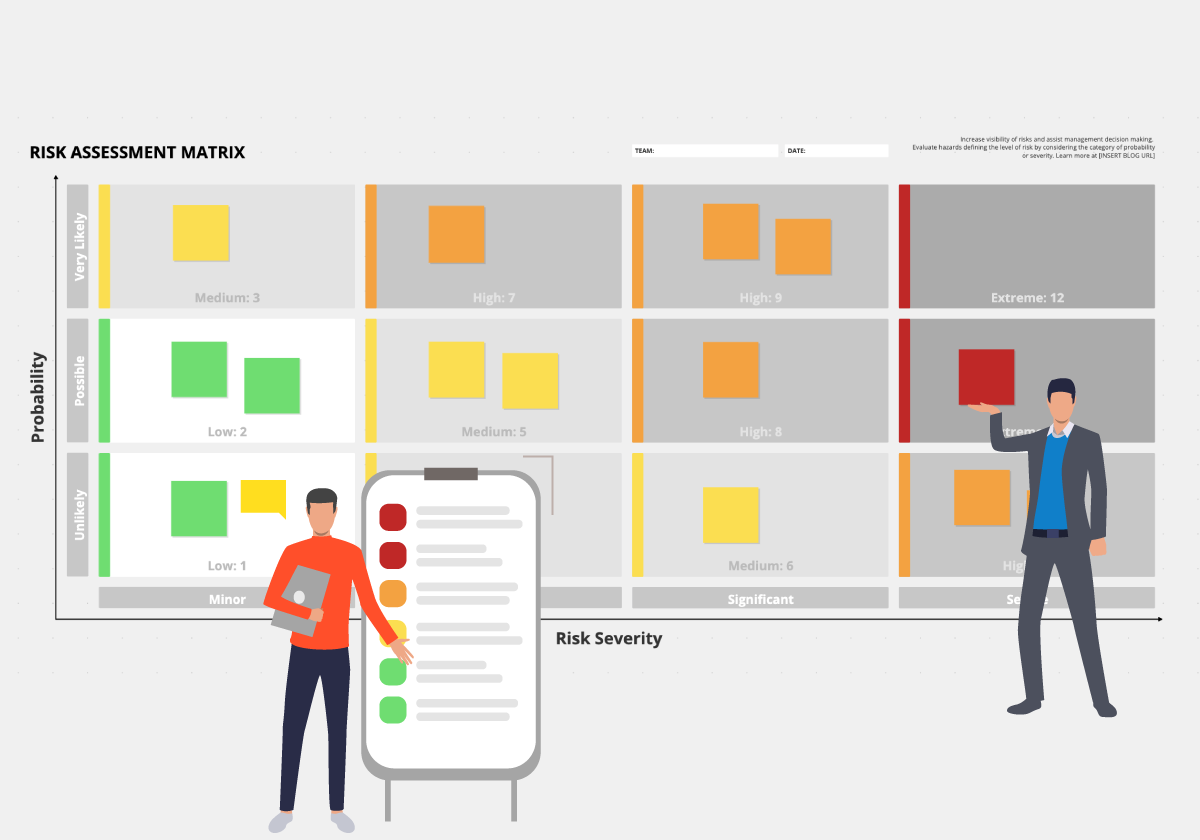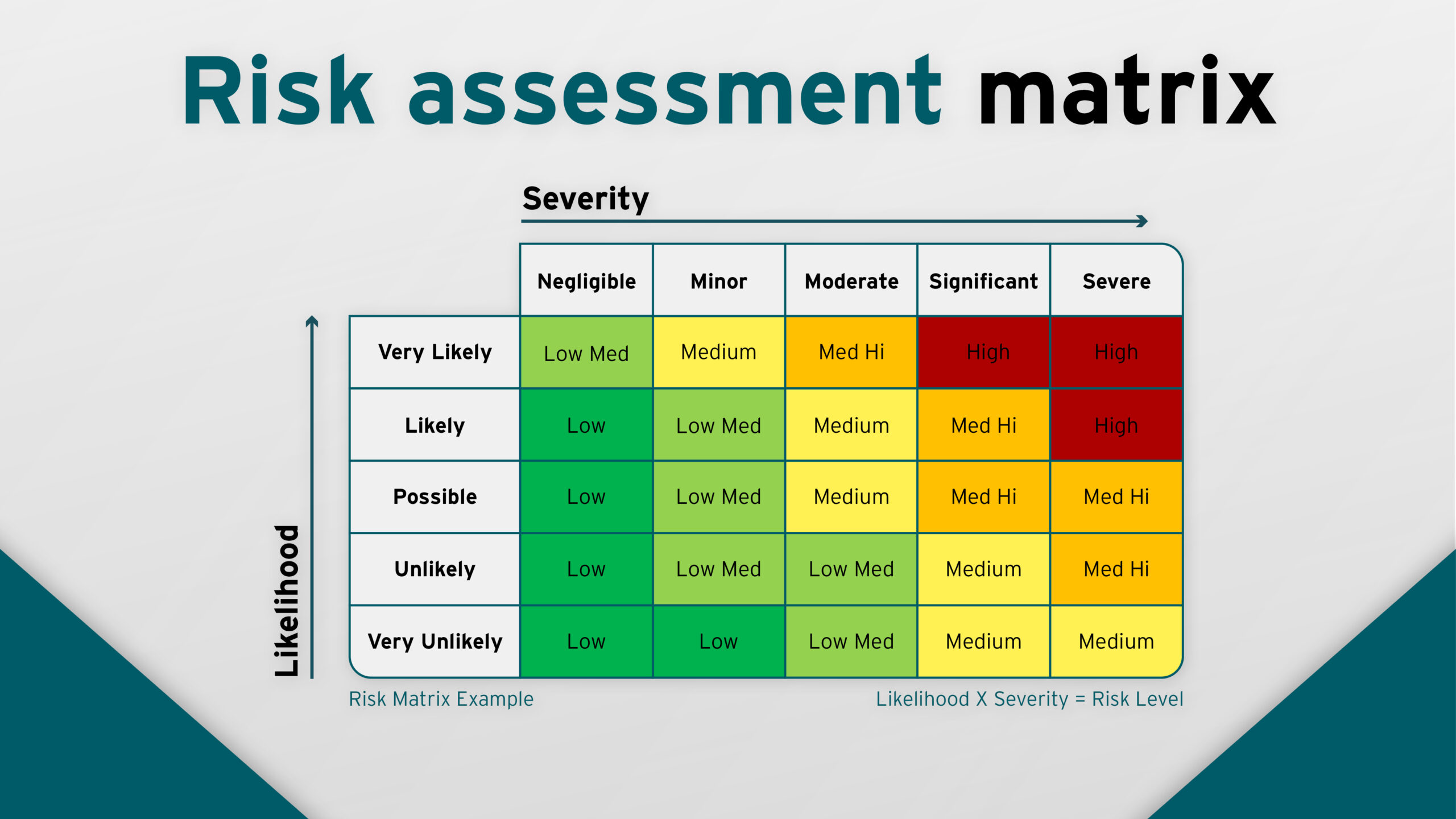What is the Risk Assessment Matrix? How Does It Contribute to The Project’s Success?
Managing risks is a critical aspect of any project plan, and it’s here that a risk assessment matrix comes into play. This visual tool is a project manager’s best friend, helping you identify, assess, and mitigate potential risks. The risk assessment matrix, also known as a probability and severity risk matrix, maps out the likelihood of a risk on one axis and its potential impact on the other. It’s a powerful tool that enhances your decision-making quality by providing a clear snapshot of the risk landscape.
So, understanding and effectively using a risk assessment matrix can be a game-changer for your project’s success. Stay tuned as we explore the indispensable project management tool. Let’s get started!
What Is a Risk Assessment Matrix?

A Risk Assessment Matrix is a practical tool that helps you detect, evaluate, and reduce potential risks that can hinder the success of your project. It’s often called a probability and severity risk matrix. This project management tool provides a visible layout where potential risks are lined up against their likelihood and potential impact on your project, with hard-hitting decision-making clarity.
To provide a clearer understanding, here’s a risk assessment matrix example:
| Low Severity | Medium Severity | High Severity
|
|
|---|---|---|---|
| High Probability | Treat the Risk | Plan Against Risk | Immediate Action |
| Medium Probability | Monitor the Risk | Treat the Risk | Plan Against Risk |
| Low Probability | Ignore the Risk | Monitor the Risk | Treat the Risk |
In this example, risks classified as high probability and high severity must be attended to urgently, while you’d only need to monitor those that are high probability but of low severity.
Components of a Risk Matrix
Let’s explore the structure of a risk assessment matrix – a tool that’s valued not just for its ability to highlight potential threats but for its inherent simplicity. Within this matrix, two primary components determine the characterization of a risk: severity and probability.
1. Severity
The key to the risk assessment matrix is correctly evaluating each identified risk’s severity. Severity assessment reflects the level of disruption each risk could cause if it materializes. Factors that may alter the severity of a risk include:
- The nature of the harm that could occur be it physical, psychological, legal, or financial
- The magnitude of the harm from minor treatment necessity to death, small budgetary loss to crippling corruption
- Influential factors such as the height involved in a fall or the concentration of a hazardous substance
- The number of people exposed to the threat who could be harmed, in or outside of the workplace.
This severity can be considered from different perspectives, such as human life impact, damage to assets or facilities, environmental implications, and reputation fallout, collectively named PEAR (People, Environment, Assets, and Reputation). Combining scores from different perspectives to create a unified severity rating can often be challenging and sometimes unworkable. It’s more effective to make a qualitative judgment for each risk individually.
2. Probability
In risk analysis, likelihood and probability are often used interchangeably. However, they serve slightly different roles in risk assessments. Understanding this distinction is critical when using a risk assessment matrix. Probability provides a measurable chance of an event happening, typically expressed as a percentage.
On the other hand, likelihood is an estimate of an event’s occurrence, generally expressed qualitatively. Essentially, ‘Probability’ attaches importance to statistically exclusive results that cover all possibilities, whereas ‘Likelihood’ pertains to scenarios that may overlap and are not exhaustive.
What is a Risk Assessment Matrix in Project Management?

The risk assessment matrix is a visual tool used by project managers. The matrix, represented on a grid, plots the potential impact of various risks. On the matrix’s left-hand side, you’ll discover the probability of a risk, while the severity of that risk forms the top axis. Combining probability’s measurable aspects with severity’s inherent nature and magnitude gives you a robust tool to guide your decision-making and risk management plans.
Why Is the Risk Assessment Matrix Important?
A risk assessment matrix is vital in the ever-evolving landscape of project management. It serves as a visual aid to recognize, analyze, and prioritize different risks involved in a project. This matrix uses several quantitative, qualitative, and semi-quantitative methods. The quantitative method, in particular, assigns numeric values to each aspect following the risk evaluation, meaning that risk impact, probability, and levels are determined quantitatively. It allows an accurate measure of a risk’s impact that can be used in a further cost-benefit analysis of needed controls. This method offers an objective result, which paints a precise picture of the risk and allows quick resolution.
What Are The Benefits of a Risk Assessment Matrix?

When handling complex projects, you may feel overwhelmed with both anticipated and unforeseen risks. This is where a risk assessment matrix comes into play. But what exactly is a risk assessment matrix, and why is it beneficial?
1. Effective Tool
A risk assessment matrix is an effective risk management tool. Used to identify, evaluate, and prioritize risks associated with your projects, it helps you track challenges and enables intelligent decision-making. It allows you to eliminate a risk’s severity by assigning it a quantitative value reflecting its likelihood and impact.
2. Swift To Use
One clear benefit of using a risk assessment matrix is the ability to identify and reduce risks swiftly. You’ll recognize areas where quick action can lessen damage. This assessment enables better resource allocation, contributing to project success.
3. Prioritize Risks
Another advantage is in prioritizing risks. A comprehensive overview of potential risks allows you to rank them against one another. It’s particularly beneficial when multiple risks arise, helping your project team stay on track, even when the unexpected occurs.
4. Minimizes Fallouts
A fourth noteworthy benefit is how it minimizes the fallout from occurring risks. Unplanned events can feel more severe if they’re not anticipated in advance. However, with the risk assessment matrix, you can create a strategy that reduces or neutralizes these impacts.
How to Create a Risk Assessment Matrix?
Creating a risk assessment matrix is essential to your project risk management journey. It isn’t as daunting as it might initially appear. Here is a step-by-step guide that will simplify the process for you.
- Gather Your Project Team: Assemble a robust project team to help identify potential risks. This team must document every risk they identify, irrespective of how small or irrelevant they may seem. Remember, it’s about casting a wide net at this stage. You’ll have the opportunity to reassess later.
- Risk Identification: The next crucial step in creating your risk matrix involves identifying potential threats that could disrupt the flow of your project. This exhaustive list should include every possible risk, keeping an open mind, and considering everything, no matter how far-fetched it may seem.
- Prioritize and Rate Each Risk: Each identified risk must now be rated based on its likelihood and the potential impact it could have on your project.
Many professionals often simplify this process using a risk assessment matrix template. It allows you to input data swiftly and graphically view the associated risks.
What are the Challenges of a Risk Matrix?

Risk matrices give you valuable insights for identifying and preparing for project risks. However, they’re not a magic solution to all your project issues. The efficiency of a risk matrix can often be challenged on various grounds. Understanding these challenges can help you use your risk assessment matrix more effectively.
- Potential For Inaccurate Assessments: The risk matrix categories might not be specific enough to differentiate between risk levels accurately. The severity and likelihood of certain risks can be subjective, making them unreliable.
- Poor Decision-Making: Improperly categorized risks can lead to inaccurate conclusions about potential issues. A risk assessment matrix template can help, but it can’t completely eliminate the risk of misjudging events.
- They Don’t Account For Timeframes: They don’t differentiate between a risk that could occur two weeks from now and one that might happen in two years. This lack of consideration could lead to misjudged actions, as a risk’s nature could notably change over time.
- Oversimplification of Risks: The complexity and volatility of risks can be downplayed considerably. Some risks remain constant, while others can alter significantly, even overnight. As you are aware of this, you should keep revisiting and updating your risk assessment matrix example. There are numerous risk-calculation tools available that can help you handle this volatility with minimum effort.
What is the Risk Assessment Matrix Template?
The Risk Assessment Matrix Template is a tool that aids in determining the overall Risk Impact based on the Severity and Likelihood of project risks. This practical tool speeds up the process of identifying, assessing, and prioritizing project risks. Let’s break down how to use a template to determine the Risk Impact.
- First, navigate to your risk matrix template’s Risk Assessment List tab.
- Find the Severity of the risk you’re assessing and follow that column downwards.
- Keep going until it intersects with the Likelihood of that risk. The cell where these two coordinates meet is your Risk Impact.
For instance, suppose your risk has ‘Acceptable’ severity and ‘Probable’ likelihood. That puts it in the ‘Medium’ risk category. You’ve now gotten hands-on experience with a risk assessment matrix example.
Having a template handy isn’t about making things complicated. It’s about quickly visualizing and measuring risk, allowing you to take proactive steps to minimize its impact on your project. Here’s how:
- Once you’re on the Risk Assessment List tab, list all the potential risks that could affect your project in the Risk column. Be as specific as possible – the more detail, the better.
- Choose a Severity option from the dropdown menu.
- Select a Likelihood option from the dropdown menu.
By following these steps, you’re not just using a risk matrix. You’re turning it into an effective tool for managing your project risks. It’s not about eliminating the possibility of risks; it’s about being well-prepared when they emerge.
Conclusion
A Risk Assessment Matrix Template can be a game-changer in project management. It’s not just about spotting risks but also about assessing and prioritizing them effectively. Remember, it’s not about eliminating risks completely but managing them effectively. Use this tool to your advantage, and your projects will run smoother than ever. Keep in mind that the power of the matrix lies in its ability to visualize risk impact based on severity and likelihood.
Frequently Asked Questions:
What is a Risk Assessment Matrix Template?
A Risk Assessment Matrix Template is a valuable tool in project management that helps to determine Risk Impact by considering the Severity and Likelihood of potential project risks.
How does a Risk Assessment Matrix Template work?
The template guides you through specific steps, allowing you to identify, assess, and prioritize the risks associated with your project. It visualizes the risks, enabling you to manage them effectively.
Is the goal of using a Risk Assessment Matrix to eliminate all risks?
No, the primary aim is not to eliminate all risks but to use it as a proactive tool for risk management.
What does a 3×3 risk matrix mean?
A 3×3 risk matrix has three levels: Severity and Likelihood of risk. It’s a standard matrix model suitable for controlling less severe risks.
When should I use a 5×5 risk matrix?
A 5×5 risk matrix is functional when your project requires detailed risk assessment. However, evaluating if this level of detail is necessary for more straightforward projects is essential.
Can you briefly explain the Simple Risk Matrix?
Sure, the Simple Risk Matrix uses Assessment Descriptors to help determine the probability and severity associated with each potential risk. You use these outputs as inputs for the Risk Matrix.
What are the steps to make a risk assessment?
The steps to make a risk assessment include identifying hazards, assessing risks, controlling risks, recording your findings, and reviewing the controls.
What makes a good risk matrix?
A good risk matrix should allow you to visualize the probability and severity of potential risks by basing on two main factors: the likelihood of the risk occurrence and the potential impact the risk event will have.

Leave a Reply